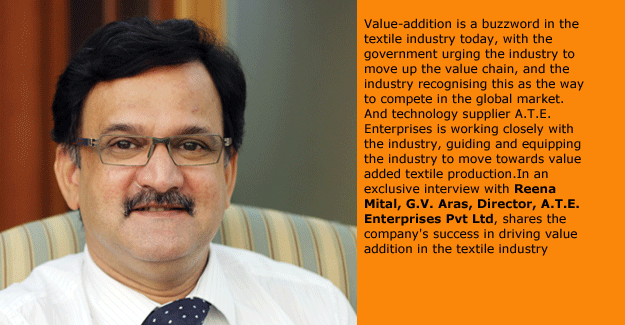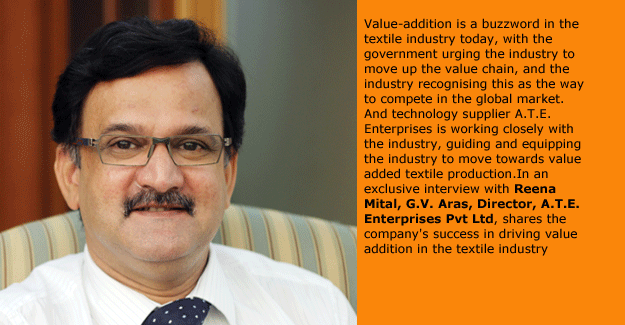
A.T.E. Plays An Important Role Of A Catalyst In Driving Value Addition In The Textile Industry
Why is the industry slow in moving up the value chain?
Moving into high value products, a company must invest in good technology, and people who can understand and absorb this technology. Companies are usually averse to high investments when they are not sure of returns. And there is a serious shortage of skilled people in the industry, especially in the processing and finishing sector. The real value addition comes at the finishing stage, when a fabric is imparted with functional properties such as coating, lamination, etc. A fabric selling at Rs 50 a metre, after finishing treatments, could sell for anything between 30-100% higher, whereas the cost of value addition will not be more than 20%. Companies with a long term vision have succeeded, but there have been failures too. I believe it is a combination of all this, that has kept the industry from moving towards value additions.
Why have there been failures?
People's reluctance to go for good technology would be the main reason. The best example here is that of spunbond fabrics, used for low priced carry bags, etc. Spunbond fabrics can have high end applications too. However, in India, most of the people invested in very low cost Chinese machines, to service a very low end market. This segment is now saturated, margins are all but lost. The industry needs to move away from its short-sighted view of the market, and move toward long term strategies. That is how the current leaders of the industry reached their positions.
What is the role of A.T.E. as a machinery supplier, to drive value addition?
It is a very important role of a catalyst. For many years now, we have been trying to convince the industry to go into higher value products. We diversified into various areas to fill the technology and value chain gaps to help the industry to move into value addition. We realised that no one in the industry could guide them end to end. So we went into synthetics, lab equipment, utilities. We get requests from textile entrepreneurs to give them an overall picture of where the opportunities are. We have the capability to fulfil these requests, and help the industry identify the opportunities from spinning to garmenting and also technical textiles.
Can you tell us about any particular segment where you guided the industry towards value addition successfully?
Excellent example would be of warp knitting. Surat is the hub of warp knitting today. Till some years ago, we used to import this fabric from China. Surat, seeing the opportunities here, invested in warp knitting heavily. The basic fabric, as such, is quite low priced, but with embroidery, other surface ornamentation and finishing, etc, the fabric can fetch a price of anything from Rs 5000-10000 and more. So, investments here happened at a staggering rate.
Today, we have a market for around 200 warp knitting machines every year. And obviously the market has reached saturation, with all the knitters making the same unfinished fabric. A.T.E. then convinced them to look at finishing the fabric, to increase the value by 100%. Finishing of warp knit fabric is difficult especially for the elastic fabrics, and the industry has been hesitant. But we have been encouraging the industry to think towards moving up the ladder.
Fong's is specialised in finishing of warp knit fabrics. So we are organising a customer day at Fong's where a group of people from Surat will be able to see the benefits of using Fong's state-of-the-art technology. They will also visit some mills in China to see the actual processing and finishing happening. The international market for finished warp knit fabrics is huge. Today, international buyers source the grey fabric from India, and then go to China or Taiwan for processing and finishing. So the value addition happens elsewhere. Now, we will see warp knit finishing happening within India.
So, I am very happy to see how the industry is moving forward today. Another positive is that the new generation has come into the industry, and they bring with them a different, more progressive mindset. India, even today produces the finest shirting fabrics, and supplies to the top brands in the world. Unfortunately, if the same fabric is exported, it would find a position in a slightly lower bracket because it is made in India. So, along with value addition, there is need for branding too, this will take time, but a brand will truly demonstrate the value of the product.
A.T.E. has done quite well this year. Do you expect investments to continue in the industry?
Yes, last financial year was very good for us. We sold 821 cards from Truetzschler, this is a record number of sales. Warp knitting is doing extremely well too. After long years of remaining subdued, we finally see investments picking in processing, this is very encouraging. Investments in processing are happening in the organised and the mid-level segments. I am sure these investments will continue for a long time. Investments in weaving have been happening since the last two years and continues. I feel, all this should ultimately lead to heavy investments in garmenting. We will have big players in garmenting eventually, and that is when we will be able to supply bulk quantities, and high quality products. Automation will also find a place in the garment factories.
What are your expectations from ITMA?
We have very high expectations obviously, as this happens once in four years, and almost every technology supplier will showcase something new. Many Indian companies have put investment plans on hold because they want to see the latest technology. ITMA 2015 is especially interesting for India as we are riding on an investment boom. India will be the market for automation. ITMA 2015 will be a game changer for the Indian textile industry. A.T.E will be present with a sizeable team, with most of our principals.

Textile Excellence
If you wish to Subscribe to Textile Excellence Print Edition, kindly fill in the below form and we shall get back to you with details.








